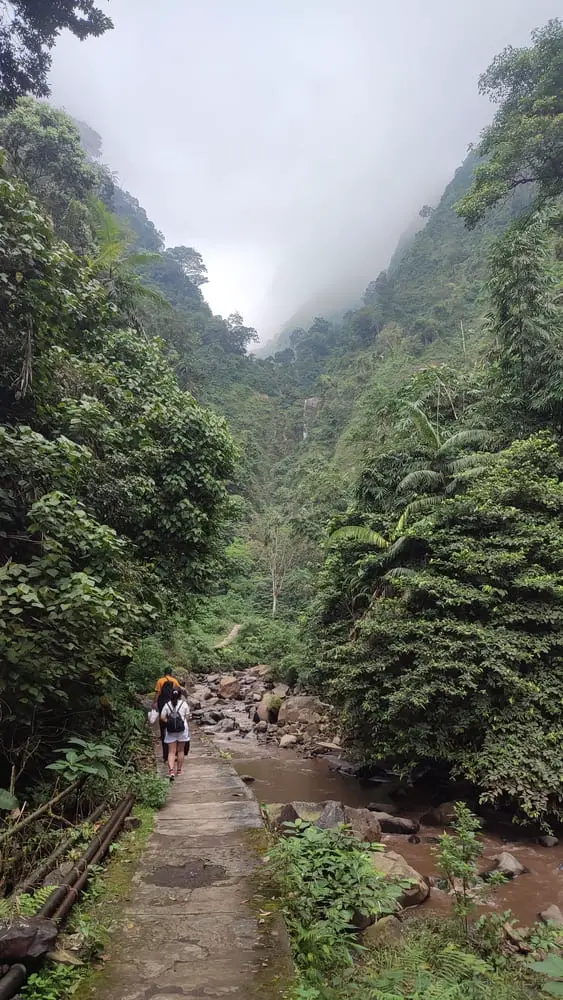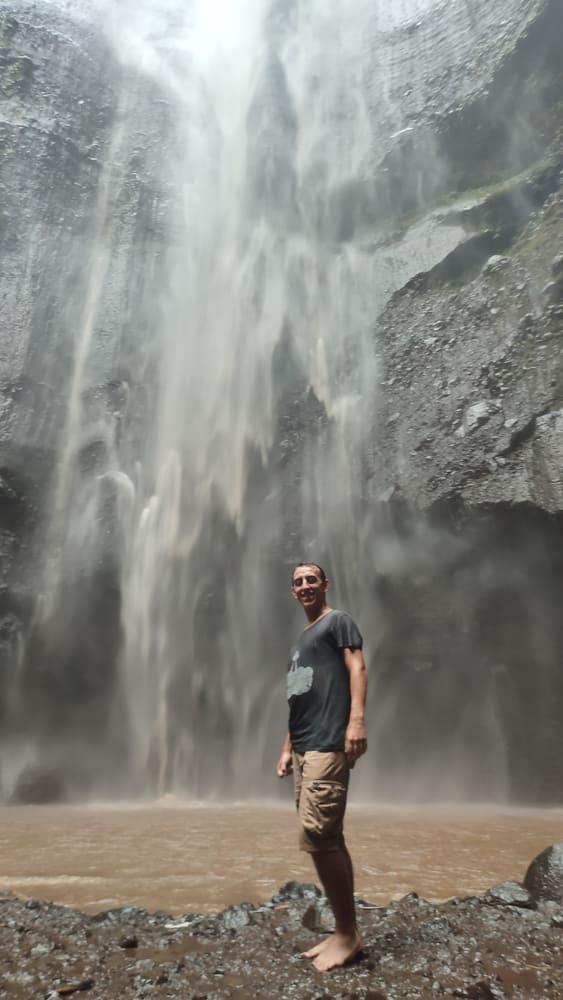Madakaripura Waterfall: The Full Guide to Java’s Highest!
This post may contain affiliate links. If you make a purchase using one of these links, I may receive a small reward at no extra cost to you. See my Disclosure Policy for more information.
In East Java, very close to the ultra-popular Mount Bromo and tucked away in thick jungle and dramatic cliffs is a rather secret natural wonder – The Madakaripura Waterfall.
Madakaripura Waterfall (called Air Terjun Madakaripura in Indonesian) is an impressive 200-meter drop of a single column of water. The second highest in Indonesia!
You can easily combine a trip to the waterfall with a visit to Mount Bromo because of their proximity. You don’t need a guide to go to either, especially because you’ve landed at the best guide to visiting Madakaripura Waterfall independently!
Madakaripura Waterfall is part of my 14-day Java Backpacking Itinerary.
Is Madakaripura Waterfall Worth a Visit?
Madakaripura waterfall is the highest one on Java and the second highest in all of Indonesia (after Sigura-Gura Waterfall, North Sumatra)!
At 200 meters in height, I guarantee it will take your breath away!
It’s uniquely tucked away in a niche, surrounded by vertical cliffs on three sides, creating a gargantuan “shower cabin” where the water falls literally on top of you. I haven’t seen anything remotely similar, and I’ve had my fair share of waterfalls!
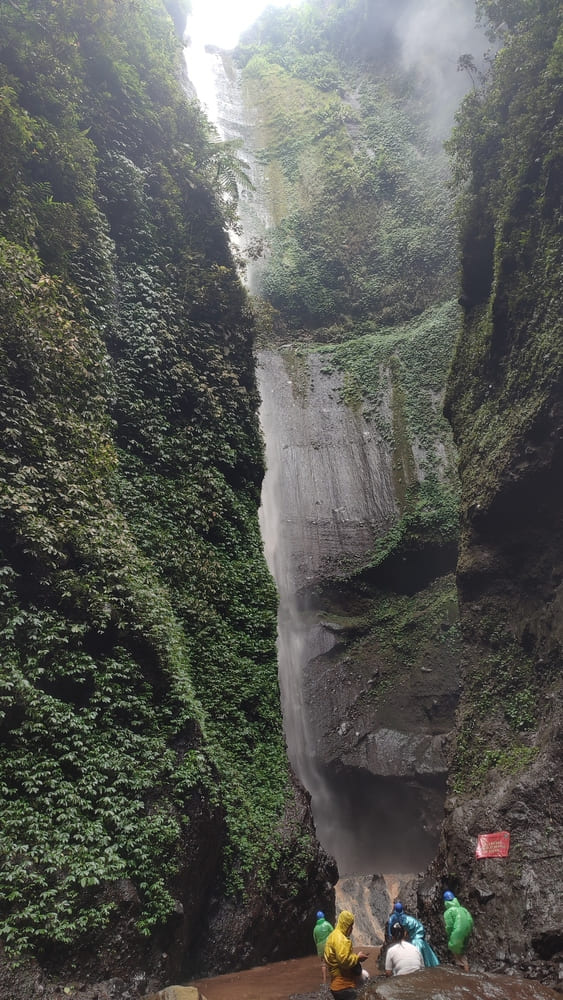
Even if you’ve seen hundreds of waterfalls, Madakaripura is still worth a visit, as it’s so outstanding in its size and majesty.
How to Get to Madakaripura Waterfall
Given its relative remoteness, no public transportation goes to Madakaripura.
The easiest way to reach Madakaripura without an organized tour is to rent a scooter in Probolinggo and go by yourself (or with a buddy at the back)
I went to Madakaripura by scooter from Probolinggo, then continued to Cemoro Lawang (on the verge of Bromo’s Caldera), where I spent the night and visited Bromo for sunrise the next morning. It’s a budget-friendly way to visit both places independently.
If you’re in Surabaya or Malang, you have to first go to Probolinggo either by various buses or using the reliable Java train network.
But you may want to consider a tour with a pick-up from either city. These tours include a visit to Mt. Bromo too because they are so close to each other:
- From Surabaya: Madakaripura + sunrise at Mt Bromo [BOOK HERE]
- From Malang: Madakaripura + sunrise at Mt Bromo [BOOK HERE]
By Scooter from Probolinggo to Madakaripura Waterfall
Probolinggo is the gateway to Madakaripura and Bromo. To get to this small city, take a train from Surabaya, Malang, or Yogyakarta.
Buses are even more convenient as they stop right next to Terminal Banyuangga, where you can immediately rent a scooter and take off towards adventure.
Renting a Scooter
The going rate for renting a scooter for 24 hours is ~150.000 IDR (10$).
You can leave your big bags at the rental place and go only with a small day-pack with essentials.
Pro tip: If you arrive in Probolinggo in the afternoon, you’re better off spending the night in the city and going to Madakaripura (and Bromo) the next day.
Probolinggo has a beautiful alun-alun (public square/park), and the central area is nice for a walk and some street food or desserts.
My advice for a place to stay is the Colorbox Hostel.
Driving and road conditions
The road up from Probolinggo is quite good. It’s almost continuously up, but the traffic is light.
From Terminal Bayuangga to the entrance to Madakaripura, it’s 26 km or around 50 minutes by motorcycle.
Drive straight until Loembang, then turn right at Pasar Loembang towards the waterfall. Input exactly this address in Google Maps for the entrance to the waterfall.
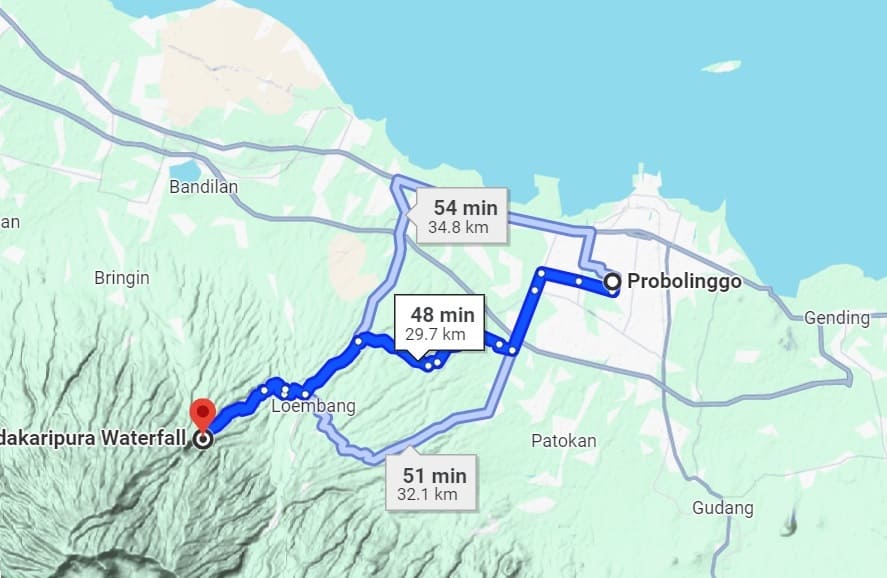
Car Park, Scams, and do you need a guide?
Just before the entrance, there’s a car park. If you come by scooter, just keep on going.
This parking is for those with a car. They park their cars there and rent a scooter taxi, also called an ojek, for the 4km to the entrance.
This service costs 15.000 IDR, though the drivers may try their luck by asking for way more – stand your ground and they will yield and agree to the fair price.
But since you’re riding your scooter, just continue straight without stopping.
Also refuse all offers for guides, ticket pre-sales, and additional services:
- You don’t need a guide
- You will buy a ticket at the entrance from the official ticket kiosk
- Anything you might need, you will find at the entrance.
Getting to the waterfall is straightforward. You don’t need a guide to visit Madakaripura. Moreover, their English is mediocre at best, and they don’t provide any significant information to make paying for them worthwhile.
The guys there will try to convince you that you must have a guide with you (i.e., them) to enter. LIES! Just say “bouten pak” (soft, throaty k, almost silent; it’s Javanese for “no thanks, sir”) and move on.
When you reach this location, park your scooter (5.000 to 8.000 IDR parking fee), and you’ll be right in front of the entrance.
Madakaripura Waterfall Entrance Fee (and other costs)
As of 2025, the entrance fee to Madakaripura Waterfall is 53.500 IDR (~3.5$) for foreigners and 33.000 IDR (~2$) for locals.
Parking costs 5.000 to 10.000 IDR (0.35-0.7$). It’s a range because it’s really up to the attendant’s mood.
Come prepared with these items, or you’ll have to rent or buy them:
- Raincoat (10.000-15.000 IDR (0.67-1$))
- Smartphone waterproof protector (5.000 IDR / 0.35 $)
- Flip-flops (10.000 IDR / 0.67$)
You can rent these either before or after the entrance.
If you think you don’t need any of those, think again very carefully – Madakaripura gets you VERY wet!
You will also have to pay 10.000 IDR (0.7$) for a locker to store your luggage. Hopefully, you’ve packed some dry spare clothes.
Inside Madakaripura Waterfall
After the entrance, there’s a pleasant 2km (~30 mins) walk to the waterfall.
In the beginning, it’s a well-maintained path, but towards the end, it becomes wet and slippery, and in the very end, it’s basically a small river.
There are a few sections where water will pour directly over you as you walk knee-deep in water.

Then, behind the last corner is a small pile of rocks. Climb over them to get directly under the main waterfall. It’s a spectacular sight and pictures don’t do it enough justice.
The combination of the spraying water, the thundering downpour, and the cold breeze create an exhilarating experience.
What to bring
This is a wet waterfall. Yeah, I know, I know, of course water is wet (or is it?), but here I mean that Madakaripura isn’t one of those waterfalls that you observe from a distance. No, no, no.
At Madakaripura, you go under the waterfall! You will be wet!
That’s why you need to bring (or rent, see above)
- Raincoat OR swimwear
- Flip-flops or aqua boots (or neither if your feet’ soles are sturdy)
- Something to put your smartphone in, preferably a transparent ziplock bag
- Spare clothes
- Towel
Madakaripura vs Tumpak Sewu
On the other side of the mountain, some 100 km south of Madakaripura, is another popular and awe-inspiring waterfall – Tumpak Sewu.
Both deserve a visit while backpacking in Java, but what’s different? Which should you pick?
Madakaripura is compact, very tall, and an adventurous experience. You get to go under the waterfall and get quite wet!
Tumpak Sewu, on the other hand, is sometimes called the “Niagara Falls of Java”. It’s a wide array of waterfalls surrounding a massive inner hole. It is a sight to behold. But behold from afar.
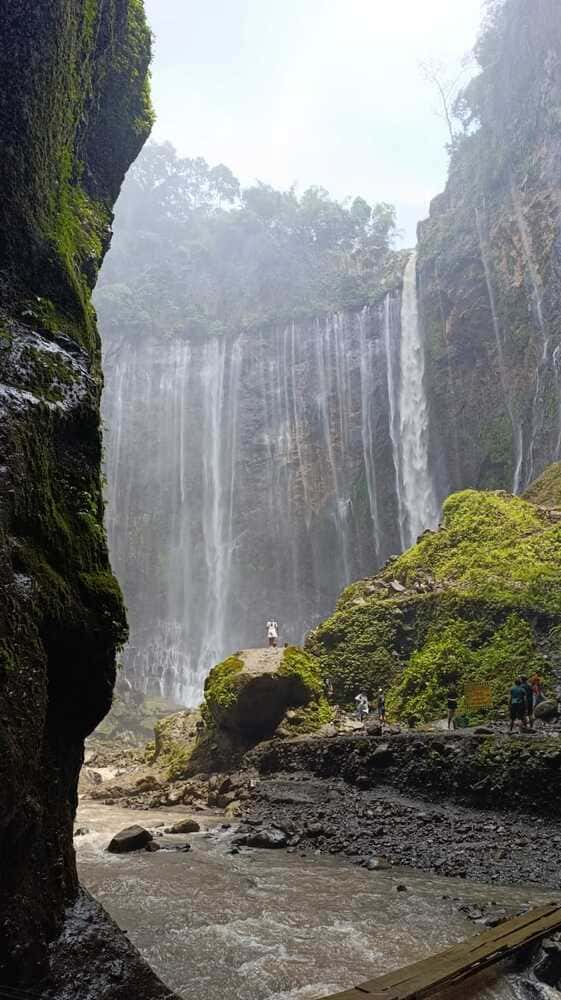
Even though you can also go down near Tumpak Sewu, it’s one of those waterfalls you want to watch and hear from a distance.
Madakaripura is a hands-on activity. It’s an adventure.
If I had to choose only one, I’d go to Madakaripura.
Where to next?
If you’re going east towards Bali, you should make a stop at Kawah Ijen, the fabled blue-flame-producing volcano with an otherworldly-blue crater lake.
If you’re going west towards Jakarta, stop at Surakarta for a booster shot of Javanese culture or proceed straight to Yogyakarta:
- Borobudur Sunrise
- Prambanan Sunset
- Visit Borobudur and Prambanan in 1 day
- Things to do in Yogyakarta
- 3 days in Yogyakarta
- Experiences in Yogyakarta
- Where to eat in Yogyakarta (local style)



